Heat Wave and Bushfire Meteorology in New South Wales, Australia: Air Quality and Health Impacts
Abstract
:1. Introduction
2. Methodology
2.1. Bushfire Periods 2019–2020
2.2. Data Analysis
Expected Results
2.3. Computational Model
2.4. Obtaining the Results
3. Results
3.1. Selected Parameters and Pollutants
3.1.1. Average Temperature
3.1.2. Average Wind Speed
3.1.3. Average Nitric Oxide (NO) Emission
3.1.4. Average Nitrogen Dioxide (NO2) Emission
3.1.5. Average Ozone Emission
3.1.6. Average Carbon Monoxide (CO) Emission
3.1.7. Average PM10 Emission
3.1.8. Average PM2.5 Emission
3.2. Health Impact
3.2.1. Computational Analysis
Geometrical Development and Boundary Conditions
Airflow Analysis
Particle Deposition Efficiency
4. Discussions
- The study analysed the air-quality data. However, a comprehensive statistical analysis is not considered for the present study. The period of several previous years will be considered in the future study for selected substances.
- The study did not analyse the hourly data during the peak bushfire periods;
- The study did not consider the bushfire data for other regions of Australia, limiting only to NSW;
- No prediction model is proposed for the air quality, which will be developed in the future study;
- The relationship between humidity and temperature will be considered in future study.
5. Conclusions
- The analysis reports that the Upper Hunter region is the hottest place compared to the other selected regions during the bushfire period.
- The monthly average Ozone in Sydney South West is higher than in other regions.
- The monthly average NO emission in the Upper Hunter region in 2018–2019 and 2019–2020 is higher than in the regions.
- The monthly average PM10 emission during the bushfire period (2019–2020) in the Upper Hunter region is higher than in other areas, and the opposite scenario is observed for the previous year (2018–2019).
- The CO, and PM2.5 emission during the four-month period of bushfire in 2019–2020 is much higher in all regions than in 2018–2019.
- The number of respiratory diseases in 2019–2020 from October to February is higher than the same data in the previous 5 years.
- PM2.5 particles have the ability to penetrate deep into the lungs. After generation G3, it is expected that 85.52% of the particle will reach the deep lung.
Supplementary Materials
Author Contributions
Funding
Institutional Review Board Statement
Informed Consent Statement
Data Availability Statement
Acknowledgments
Conflicts of Interest
References
- Graham, A.M.; Pringle, K.J.; Pope, R.J.; Arnold, S.R.; Conibear, L.A.; Burns, H.; Rigby, R.; Borchers-Arriagada, N.; Butt, E.W.; Kiely, L.; et al. Impact of the 2019/2020 Australian megafires on air quality and health. GeoHealth 2021, 5, e2021GH000454. [Google Scholar] [CrossRef] [PubMed]
- Phillips, S.; Wallis, K.; Lane, A. Quantifying the impacts of bushfire on populations of wild koalas (Phascolarctos cinereus): Insights from the 2019/2020 fire season. Ecol. Manag. Restor. 2021, 22, 80–88. [Google Scholar] [CrossRef]
- Law, B.S.; Gonsalves, L.; Burgar, J.; Brassil, T.; Kerr, I.; O’Loughlin, C. Fire severity and its local extent are key to assessing impacts of Australian mega-fires on koala (Phascolarctos cinereus) density. Glob. Ecol. Biogeogr. 2022, 31, 714–726. [Google Scholar] [CrossRef]
- Khan, S.J. Ecological consequences of Australian “Black Summer” (2019–2020) fires: A synthesis of Australian Commonwealth Government report findings. Integr. Environ. Assess. Manag. 2021, 17, 1136–1140. [Google Scholar] [CrossRef] [PubMed]
- Dowdy Andrew, J. Seamless climate change projections and seasonal predictions for bushfires in Australia. J. South. Hemisph. Earth Syst. Sci. 2020, 70, 120–138. [Google Scholar] [CrossRef]
- Australian Bureau of Meteorology. Tracking Australia’s Climate Through; Australian Bureau of Meteorology: Melbourne, Australia, 2019. [Google Scholar]
- NSW Health. Available online: https://www.health.nsw.gov.au/environment/air/Pages/faqs.aspx (accessed on 17 May 2022).
- Lucas, C.; Hennessy, K.; Mills, G.; Bathols, J. Bushfire weather in southeast Australia: Recent trends and projected climate change impacts. In Consultancy Report Prepared for the Climate Institute of Australia; Bushfire CRC: Melbourne, Australia, 2007; Volume 84. [Google Scholar]
- Delfino, R.J.; Brummel, S.; Wu, J.; Stern, H.; Ostro, B.; Lipsett, M.; Winer, A.; Street, D.H.; Zhang, L.; Tjoa, T.; et al. The relationship of respiratory and cardiovascular hospital admissions to the southern California wildfires of 2003. Occup. Environ. Med. 2009, 66, 189–197. [Google Scholar] [CrossRef] [Green Version]
- Johnston, F.; Hanigan, I.; Henderson, S.; Morgan, G.; Bowman, D. Extreme air pollution events from bushfires and dust storms and their association with mortality in Sydney, Australia 1994–2007. Environ. Res. 2010, 111, 811–816. [Google Scholar] [CrossRef]
- Naeher, L.P.; Brauer, M.; Lipsett, M.; Zelikoff, J.T.; Simpson, C.D.; Koenig, J.Q.; Smith, K.R. Woodsmoke health effects: A review. Inhal. Toxicol. 2007, 19, 67–106. [Google Scholar] [CrossRef]
- Black, C.; Tesfaigzi, Y.; Bassein, J.A.; Miller, L.A. Wildfire smoke exposure and human health: Significant gaps in research for a growing public health issue. Environ. Toxicol. Pharmacol. 2017, 55, 186–195. [Google Scholar] [CrossRef]
- Liu, J.C.; Pereira, G.; Uhl, S.A.; Bravo, M.A.; Bell, M.L. A systematic review of the physical health impacts from non-occupational exposure to wildfire smoke. Environ. Res. 2015, 136, 120–132. [Google Scholar] [CrossRef] [Green Version]
- Borchers Arriagada, N.; Palmer, A.J.; Bowman, D.M.J.S.; Morgan, G.G.; Jalaludin, B.B.; Johnston, F.H. Unprecedented smoke-related health burden associated with the 2019–2020 bushfires in eastern Australia. Med. J. Aust. 2020, 213, 282–283. [Google Scholar] [CrossRef] [PubMed]
- Larpruenrudee, P.; Surawski, N.C.; Islam, M.S. The Effect of Metro Construction on the Air Quality in the Railway Transport System of Sydney, Australia. Atmosphere 2022, 13, 759. [Google Scholar] [CrossRef]
- Dennekamp, M.; Abramson, M.J. The effects of bushfire smoke on respiratory health. Respirology 2011, 16, 198–209. [Google Scholar] [CrossRef] [PubMed]
- Islam, M.S.; Paul, G.; Ong, H.X.; Young, P.M.; Gu, Y.T.; Saha, S.C. A Review of Respiratory Anatomical Development, Air Flow Characterization and Particle Deposition. Int. J. Environ. Res. Public Health 2020, 17, 380. [Google Scholar] [CrossRef] [PubMed] [Green Version]
- Russell, A.G.; Brunekreef, B. A Focus on Particulate Matter and Health. Environ. Sci. Technol. 2009, 43, 4620–4625. [Google Scholar] [CrossRef] [Green Version]
- Singh, P.; Raghav, V.; Padhmashali, V.; Paul, G.; Islam, M.S.; Saha, S.C. Airflow and Particle Transport Prediction through Stenosis Airways. Int. J. Environ. Res. Public Health 2020, 17, 1119. [Google Scholar] [CrossRef] [Green Version]
- Berg, E.J.; Robinson, R.J. Stereoscopic particle image velocimetry analysis of healthy and emphysemic alveolar sac models. J. Biomech. Eng. 2011, 133, 061004. [Google Scholar] [CrossRef]
- Larpruenrudee, P.; Islam, M.S.; Paul, G.; Paul, A.R.; Gu, Y.T.; Saha, S.C. Model for Pharmaceutical aerosol transport through stenosis airway. Handb. Lung Target. Drug Deliv. Syst. 2021, 91, 128. [Google Scholar]
- Islam, M.; Gu, Y.; Farkas, A.; Paul, G.; Saha, S. Helium–Oxygen Mixture Model for Particle Transport in CT-Based Upper Airways. US Natl. Libr. Med. Natl. Inst. Health 2020, 17, 3574. [Google Scholar] [CrossRef]
- Islam, M.; Saha, S.; Sauret, E.; Ong, H.; Yong, P.; Gu, Y. Euler–Lagrange approach to investigate respiratory anatomical shape effects on aerosol particle transport and deposition. Toxicol. Res. Appl. 2021, 3, 1–15. [Google Scholar] [CrossRef] [Green Version]
- Ma, L.; Qi, H.; Sun, Z. Research progress on aerosol particle size distribution characteristics and respiratory system exposure assessment. Acta Sci. Circumstantiae 2020, 40, 3549–3558. [Google Scholar]
- Laumbach, R.; Kipen, H. Respiratory health effects of air pollution: Update on biomass smoke and traffic pollution. Natl. Cent. Biotechnol. Inf. 2012, 129, 3–11. [Google Scholar] [CrossRef] [PubMed] [Green Version]
- Islam, M.S.; Larpruenrudee, P.; Paul, A.R.; Paul, G.; Gemci, T.; Gu, Y.; Saha, S.C. SARS-CoV-2 aerosol: How far it can travel to the lower airways? J. Phys. Fluids 2021, 33, 061903. [Google Scholar] [CrossRef] [PubMed]
- Kumar, P.; Morawska, L.; Birmili, W.; Paasonen, P.; Hu, M.; Kulmala, M.; Harrison, R.M.; Norford, L.; Britter, R. Ultrafine particles in cities. Environ. Int. 2014, 66, 1–10. [Google Scholar] [CrossRef] [PubMed] [Green Version]
- Wang, H.; Reponen, T.; Lee, S.A.; White, E.; Grinshpun, S.A. Size distribution of airborne mist and endotoxin-containing particles in metalworking fluid environments. J. Occup. Environ. Hyg. 2007, 4, 157–165. [Google Scholar] [CrossRef]
- Islam, M.; Saha, S.; Sauret, E.; Gu, Y.; Ristovski, Z. Numerical Investigation of Aerosol Particle Transport and Deposition in Realistic Lung Airway. In Proceedings of the 6th International Conference on Computational Methods; ScienTech Publisher: Mason, OH, USA, 2015. [Google Scholar]
- Hendryx, M.; Islam, M.S.; Dong, G.-H.; Paul, G. Air Pollution Emissions 2008–2018 from Australian Coal Mining: Implications for Public and Occupational Health. Int. J. Environ. Res. Public Health 2020, 17, 1570. [Google Scholar] [CrossRef] [Green Version]
- Kurt, O.K.; Zhang, J.; Pinkerton, K.E. Pulmonary health effects of air pollution. Curr. Opin. Pulm. Med. 2016, 22, 138–143. [Google Scholar] [CrossRef]
- O’Connor, G.T.; Neas, L.; Vaughn, B.; Kattan, M.; Mitchell, H.; Crain, E.F.; Evans, R.; Gruchalla, R.; Morgan, W.; Stout, J.; et al. Acute respiratory health effects of air pollution on children with asthma in US inner cities. J. Allergy Clin. Immunol. 2008, 121, 1133–1139. [Google Scholar] [CrossRef] [Green Version]
- Areal, A.T.; Zhao, Q.; Wigmann, C.; Schneider, A.; Schikowski, T. The effect of air pollution when modified by temperature on respiratory health outcomes: A systematic review and meta-analysis. Sci. Total Environ. 2021, 811, 152336. [Google Scholar] [CrossRef]
- Watson, B.K.; Sheppeard, V. Managing respiratory effects of air pollution. Aust. J. Gen. Pract. 2005, 34, 1033. [Google Scholar]
- Office of Environment and Heritage. Hunter Climate Change Shapshot 2021, NSW Department of Planning & Environment, Sydney. 2021. Available online: https://www.climatechange.environment.nsw.gov.au/sites/default/files/2021-06/Hunter%20climate%20change%20snapshot.pdf?la=en&hash=50E9A71AA1C43339A1B82C34384D36E1A2C693D2 (accessed on 17 November 2020).
- Hosker, R.P. Flow around isolated structures and building clusters, a review. ASHRAE Trans. 1985, 91, 1672–1692. [Google Scholar]
- Pesic, D.; Zigar, D.; Anghel, I.; Glisovic, S. Large Eddy Simulation of wind flow impact on fire-induced indoor and outdoor air pollutuin in an idealised street canyon. J. Wind. Eng. Ind. Aerodyn. 2016, 155, 89–99. [Google Scholar] [CrossRef]
- Cichowicz, R.; Dobrzanski, M. 3D Spatial Analysis of Particulate Matter (PM10, PM2.5 and PM1.0) and Gaseous Pollutants (H2S, SO2 and VOC) in Urban Areas Surrounding a Large Heat and Power Plant. Energies 2021, 14, 4070. [Google Scholar] [CrossRef]
- Lateb, M.; Meroney, R.N.; Yataghene, M.; Fellouah, H.; Saleh, F.; Boufadel, M.C. On the use of numerical modelling for near-field pollutant dispersion in urban environments—A review. Environ. Pollut. 2016, 208, 271–283. [Google Scholar] [CrossRef] [Green Version]
- Atamaleki, A.; Zarandi, S.M.; Fakhri, Y.; Mehrizi, E.A.; Hesam, G.; Faramarzi, M.; Darbandi, M. Estimation of air pollutants emission (PM10, CO, SO2 and NOx) during development of the industry using AUSTAL 2000 model: A review method for sustainable development. MethodsX 2019, 6, 1581–1590. [Google Scholar] [CrossRef]
- Cichowicz, R.; Dobrzanski, M. Modeling Pollutant Emissions: Influence of Two Heat and Power Plants on Urban Air Quality. Energies 2021, 14, 5218. [Google Scholar] [CrossRef]
- Weibel, E.R. Morphometry of the Human Lung; Spring: Berlin/Heidelberg, Germany, 1963. [Google Scholar]
- Brook, R.D.; Rajagopalan, S. Particulate matter, air pollution, and blood pressure. J. Am. Soc. Hypertens. 2009, 3, 332–350. [Google Scholar] [CrossRef]
- Solomon, P.A.; Costantini, M.; Grahame, T.J.; Gerlofs-Nijland, M.E.; Cassee, F.R.; Russell, A.G.; Brook, J.R.; Hopke, P.K.; Hidy, G.; Phalen, R.F. Air pollution and health: Bridging the gap from sources to health outcomes: Conference summary. Air Qual. Atmos. Health 2012, 5, 9–62. [Google Scholar] [CrossRef]
- Rahman, M.M.; Zhao, M.; Islam, M.S.; Dong, K.; Saha, S.C. Aerosol Particle Transport and Deposition in Upper and Lower Airways of Infant, Child and Adult Human Lungs. Atmosphere 2021, 12, 1402. [Google Scholar] [CrossRef]
- Islam, M.S.; Larpruenrudee, P.; Hossain, S.I.; Rahimi-Gorji, M.; Gu, Y.; Saha, S.C.; Paul, G. Polydisperse aerosol transport and deposition in upper airways of age-specific lung. Int. J. Environ. Res. Public Health 2021, 18, 6239. [Google Scholar] [CrossRef]
- Rahman, M.M.; Zhao, M.; Islam, M.S.; Dong, K.; Saha, S.C. Aging effects on airflow distribution and micron-particle transport and deposition in a human lung using CFD-DPM approach. Adv. Powder Technol. 2021, 32, 3506–3516. [Google Scholar] [CrossRef]
- Douglass, J.A. How can air quality affect health? Intern. Med. J. 2020, 50, 1403–1404. [Google Scholar] [CrossRef] [PubMed]
- Ghosh, A.; Islam, M.S.; Saha, S.C. Targeted Drug Delivery of Magnetic Nano-Particle in the Specific Lung Region. Computation 2020, 8, 10. [Google Scholar] [CrossRef] [Green Version]
- Cheng, Y.-S.; Smith, S.M.; Yeh, H.-C.; Kim, D.-B.; Cheng, K.-H.; Swift, D.L. Deposition of ultrafine aerosols and thoron progeny in replicas of nasal airways of young children. Aerosol Sci. Technol. 1995, 23, 541–552. [Google Scholar] [CrossRef]
- Hofmann, W. Dose calculations for the respiratory tract from inhaled natural radioactive nuclides as a function of age–II. Basal cell dose distributions and associated lung cancer risk. Health Phys. 1982, 43, 31–44. [Google Scholar] [CrossRef]
- Oakes, J.M.; Roth, S.C.; Shadden, S.C. Airflow simulations in infant, child, and adult pulmonary conducting airways. Ann. Biomed. Eng. 2018, 46, 498–512. [Google Scholar] [CrossRef]
- Katan, J.T.; Hofemeier, P.; Sznitman, J. Computational models of inhalation therapy in early childhood: Therapeutic aerosols in the developing acinus. J. Aerosol Med. Pulm. Drug Deliv. 2016, 29, 288–298. [Google Scholar] [CrossRef]
- Haddrell, A.E.; Lewis, D.; Church, T.; Vehring, R.; Murnane, D.; Reid, J.P. Pulmonary aerosol delivery and the importance of growth dynamics. Ther. Deliv. 2017, 8, 1051–1061. [Google Scholar] [CrossRef] [Green Version]
- Gemci, T.; Ponyavin, V.; Chen, Y.; Chen, H.; Collins, R. Computational model of airflow in upper 17 generations of human respiratory tract. J. Biomech. 2008, 41, 2047–2054. [Google Scholar] [CrossRef]
- Loring, S.H.; Topulos, G.P.; Hubmayr, R.D. Transpulmonary pressure: The importance of precise definitions and limiting assumptions. Am. J. Respir. Crit. Care Med. 2016, 194, 1452–1457. [Google Scholar] [CrossRef]
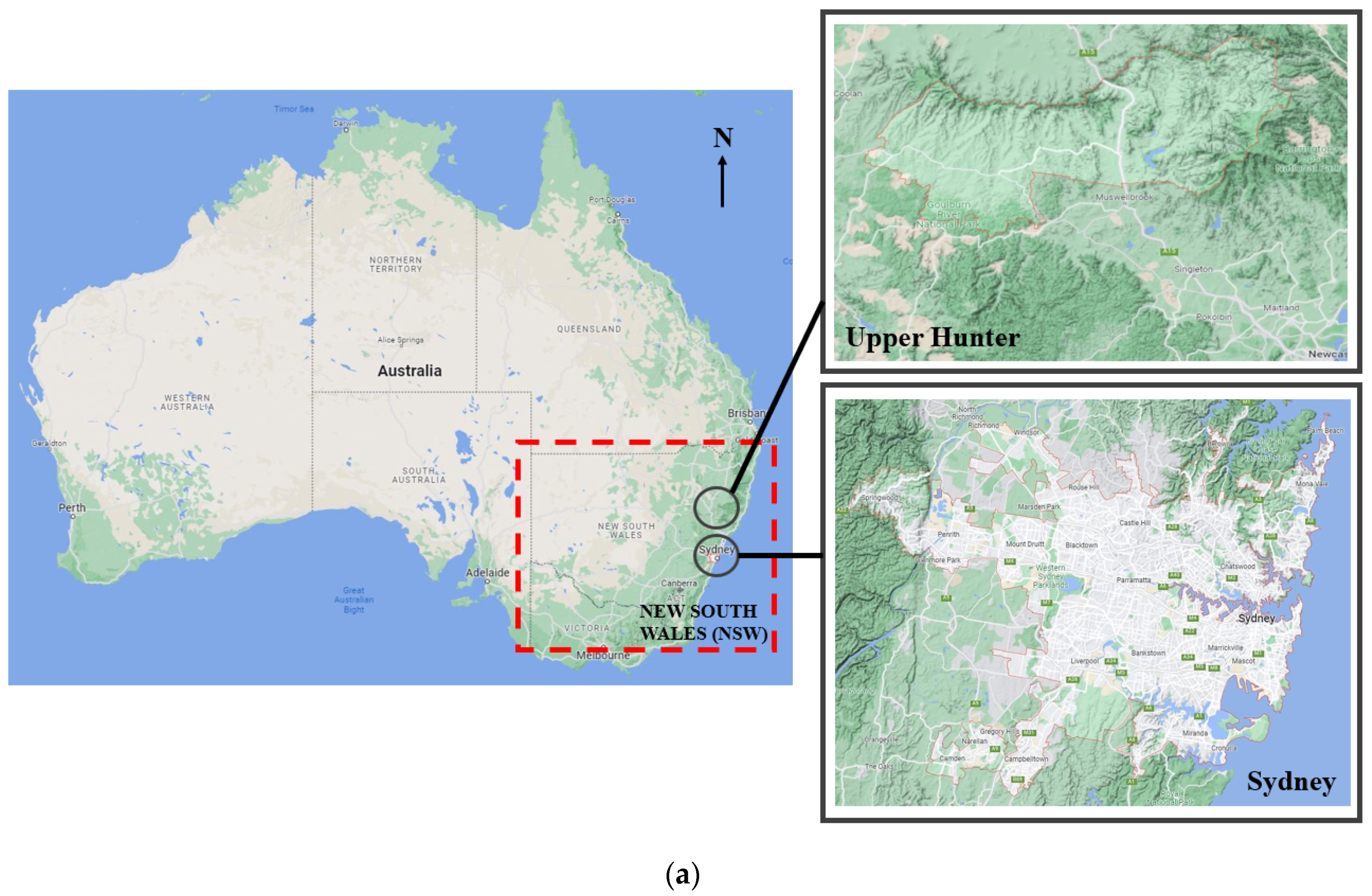


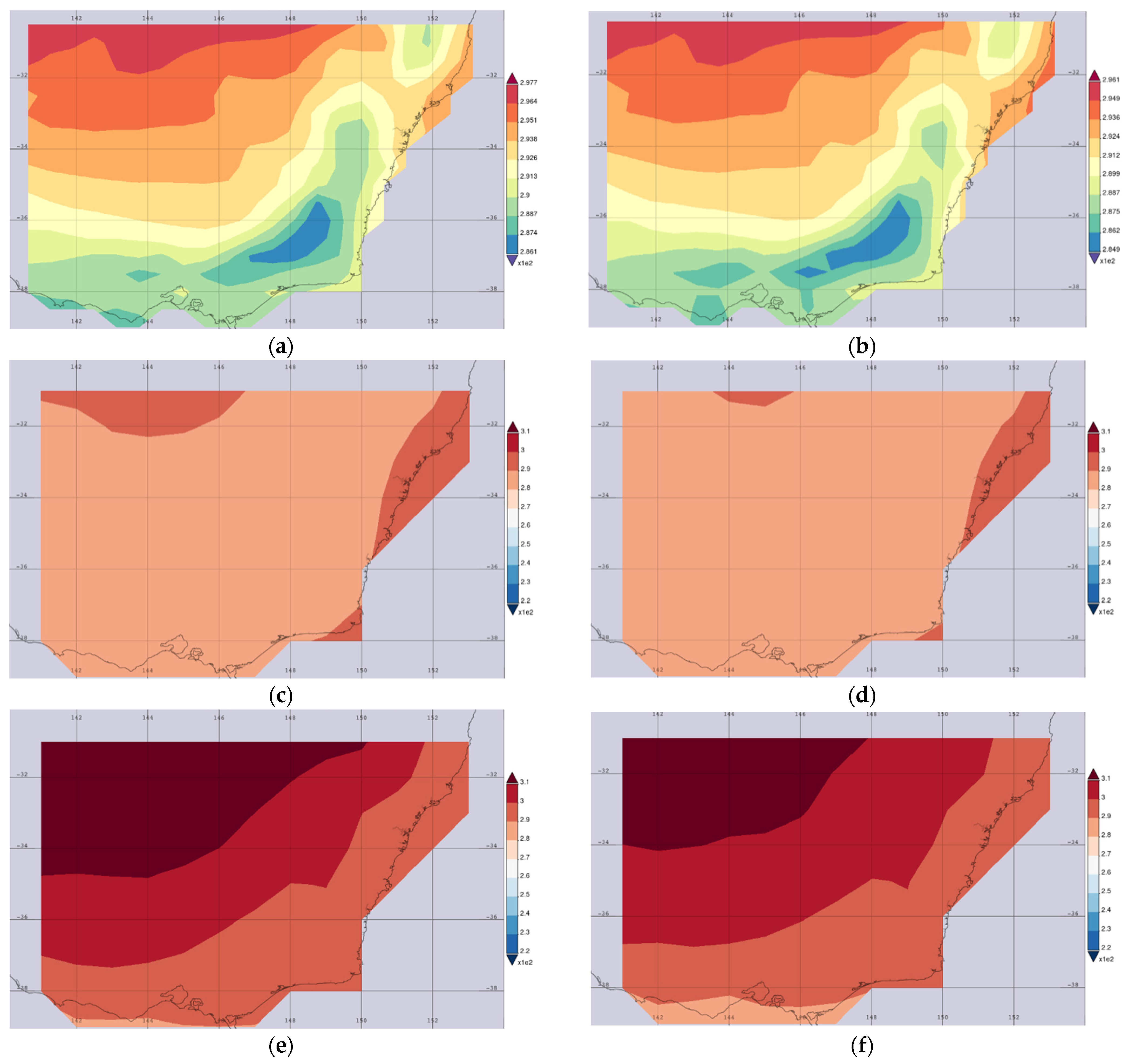

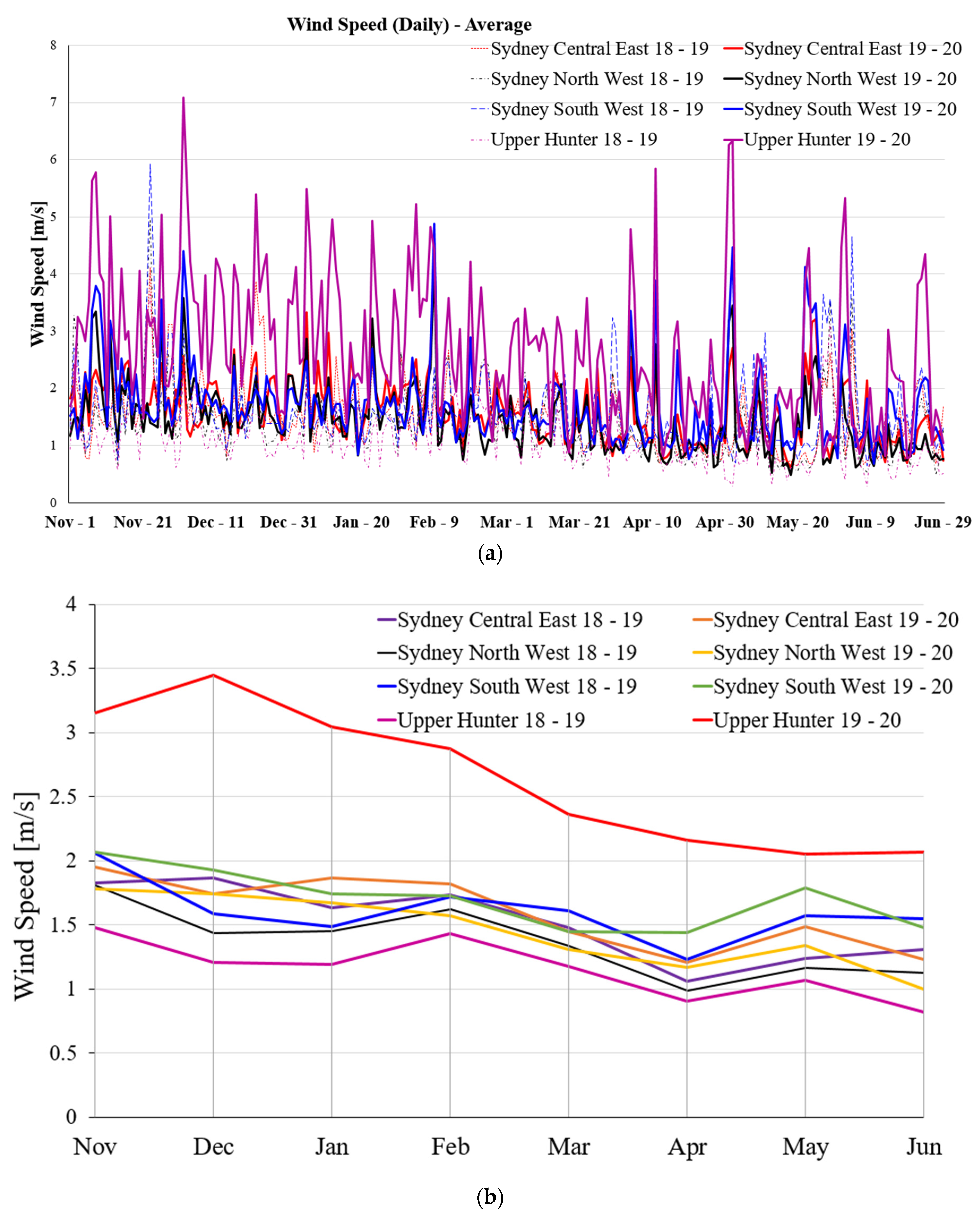
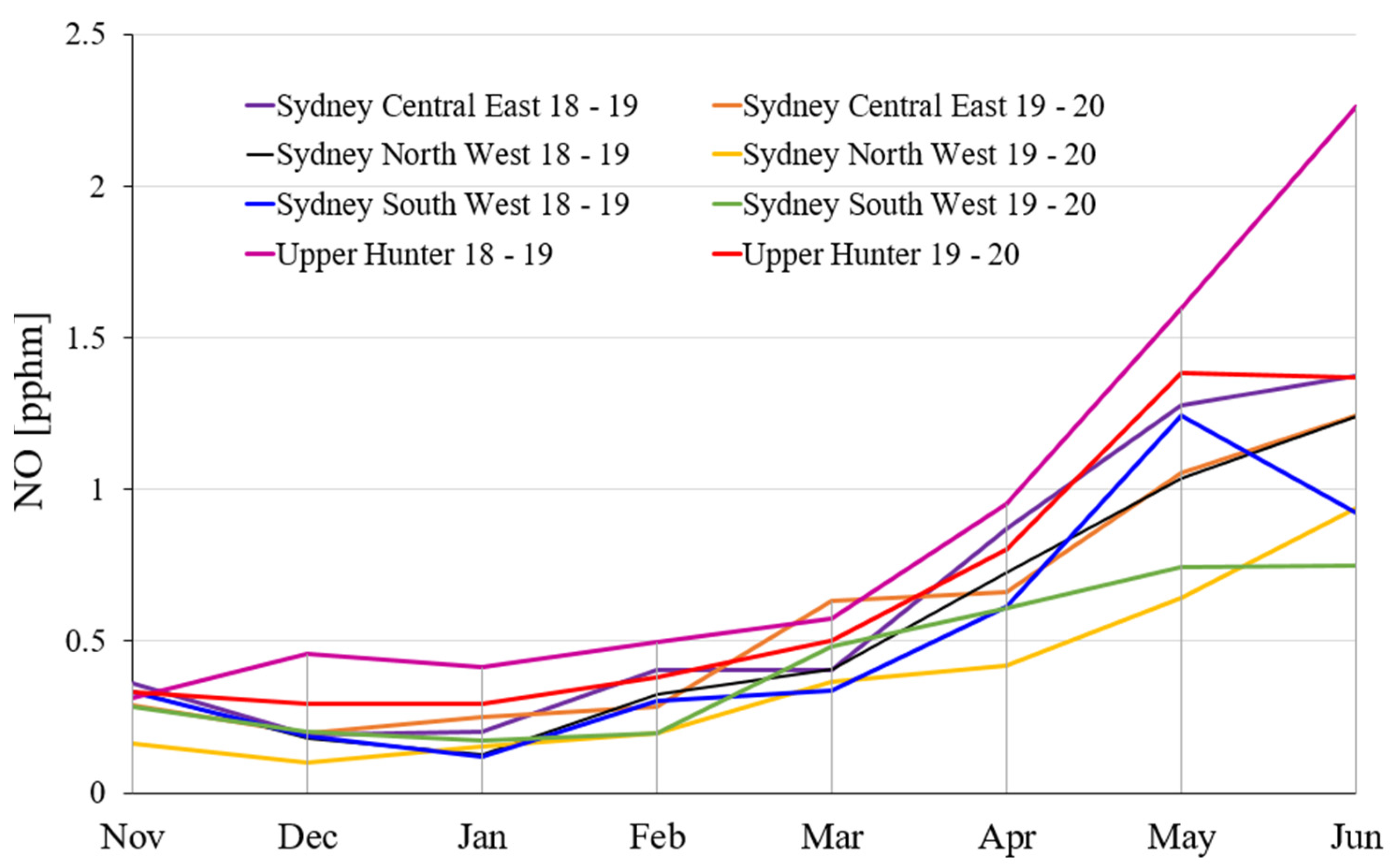
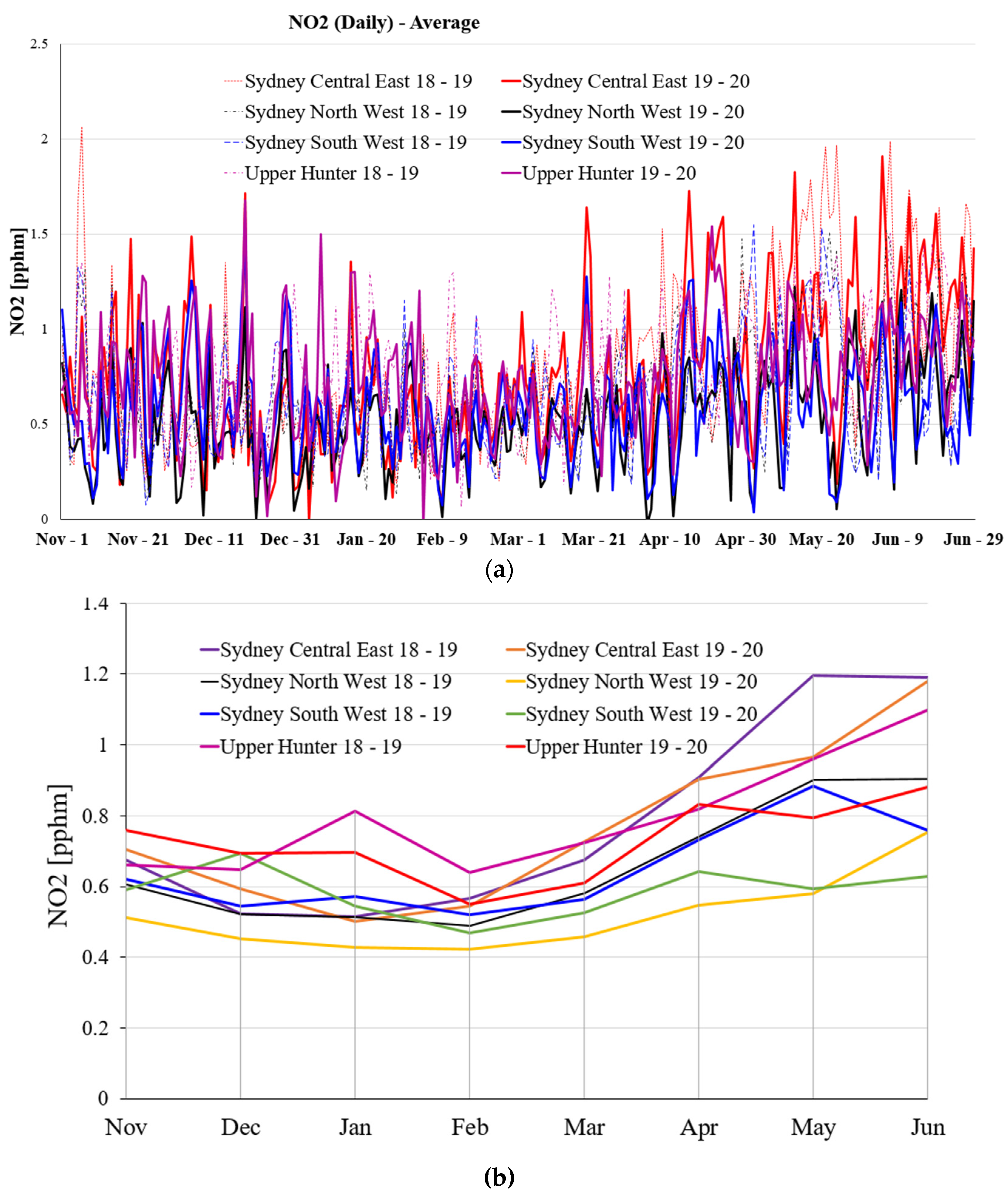



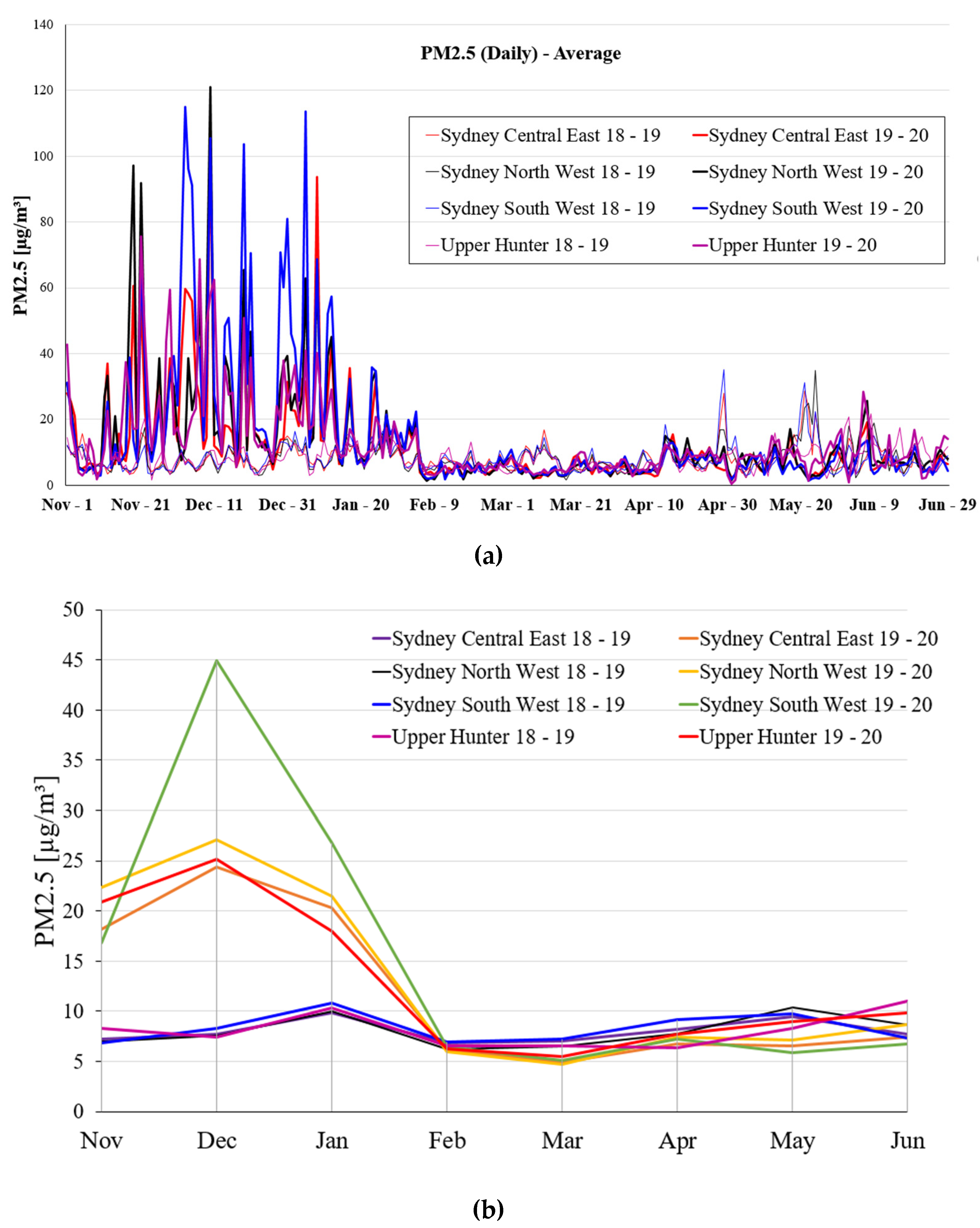
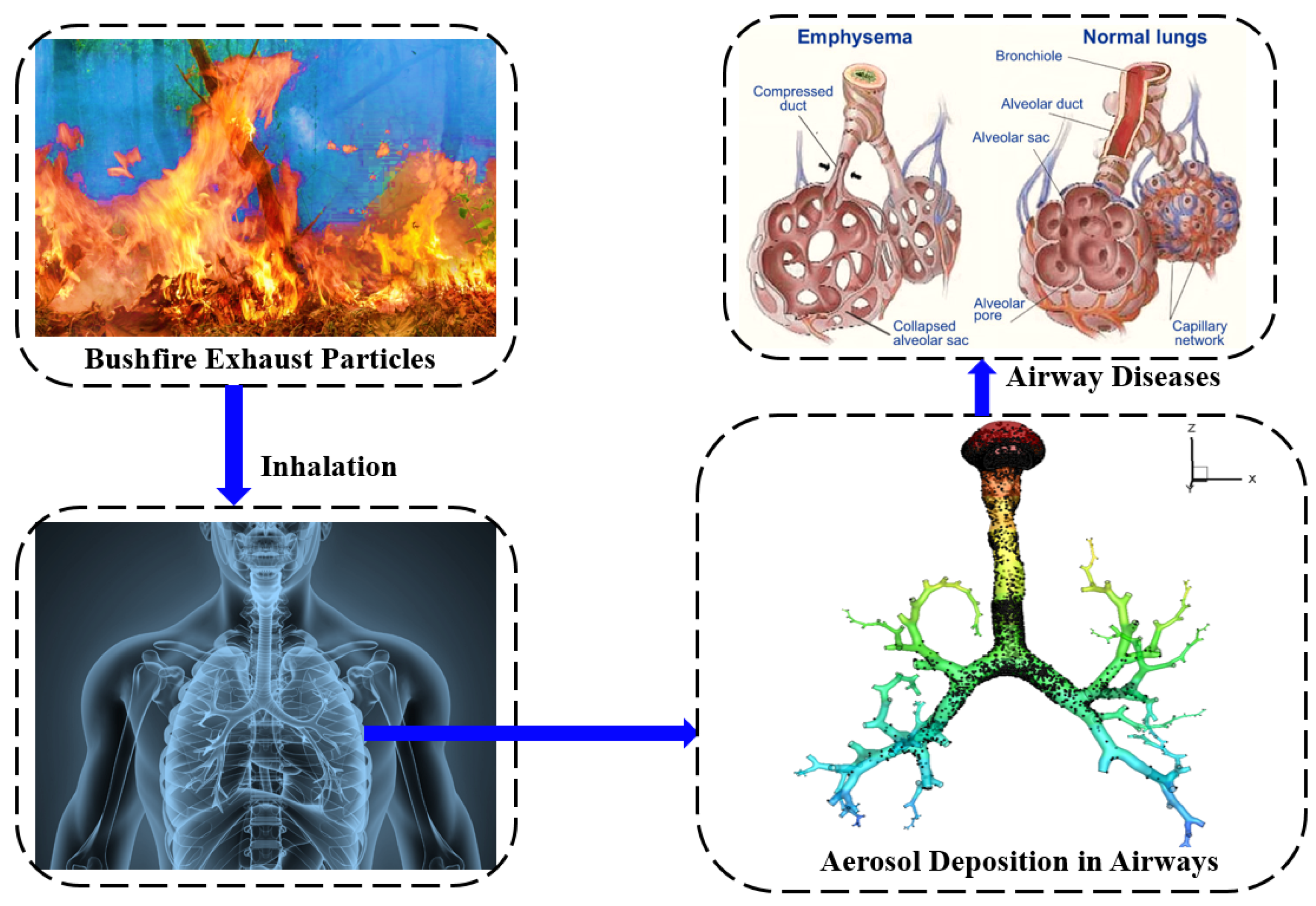

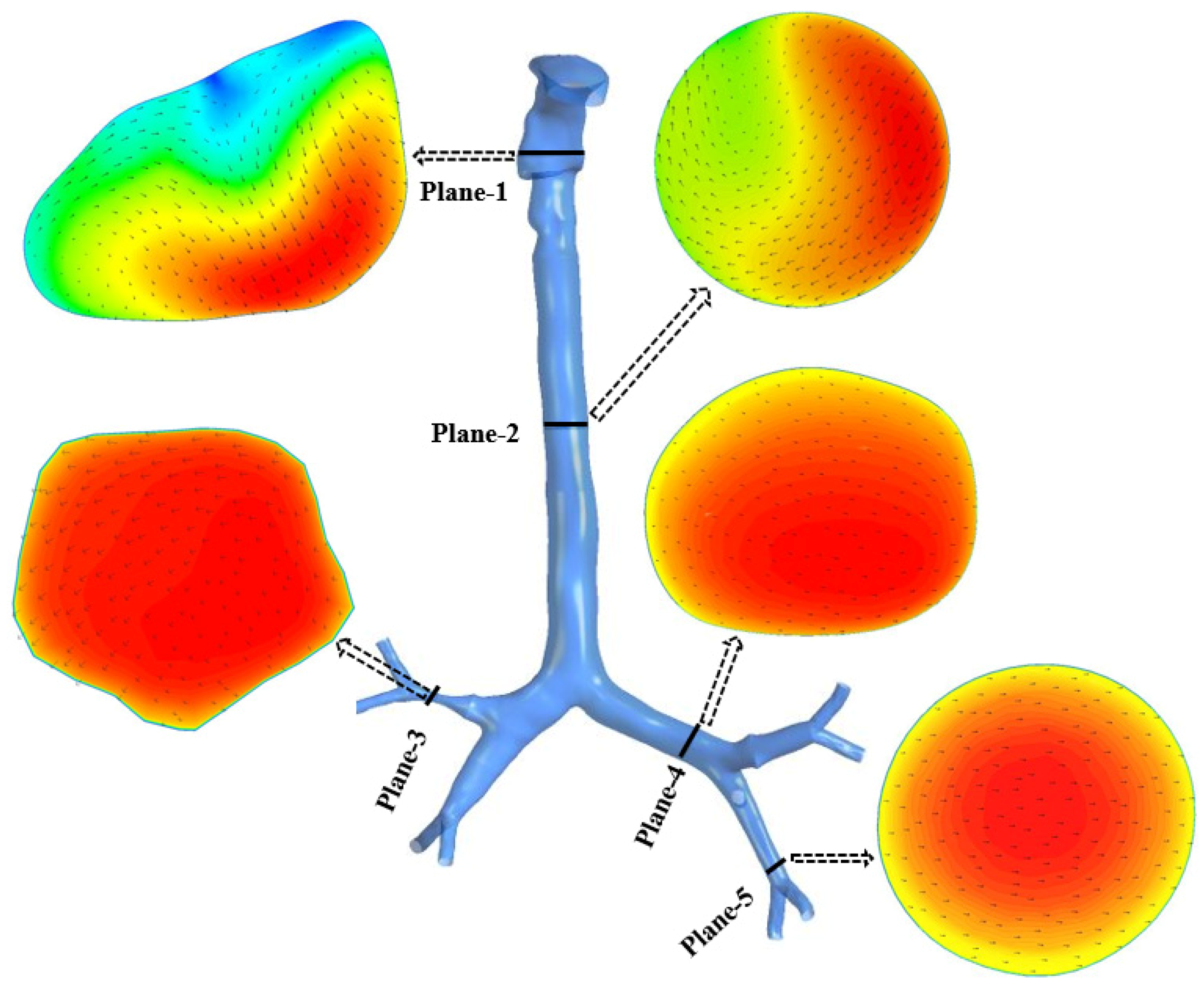
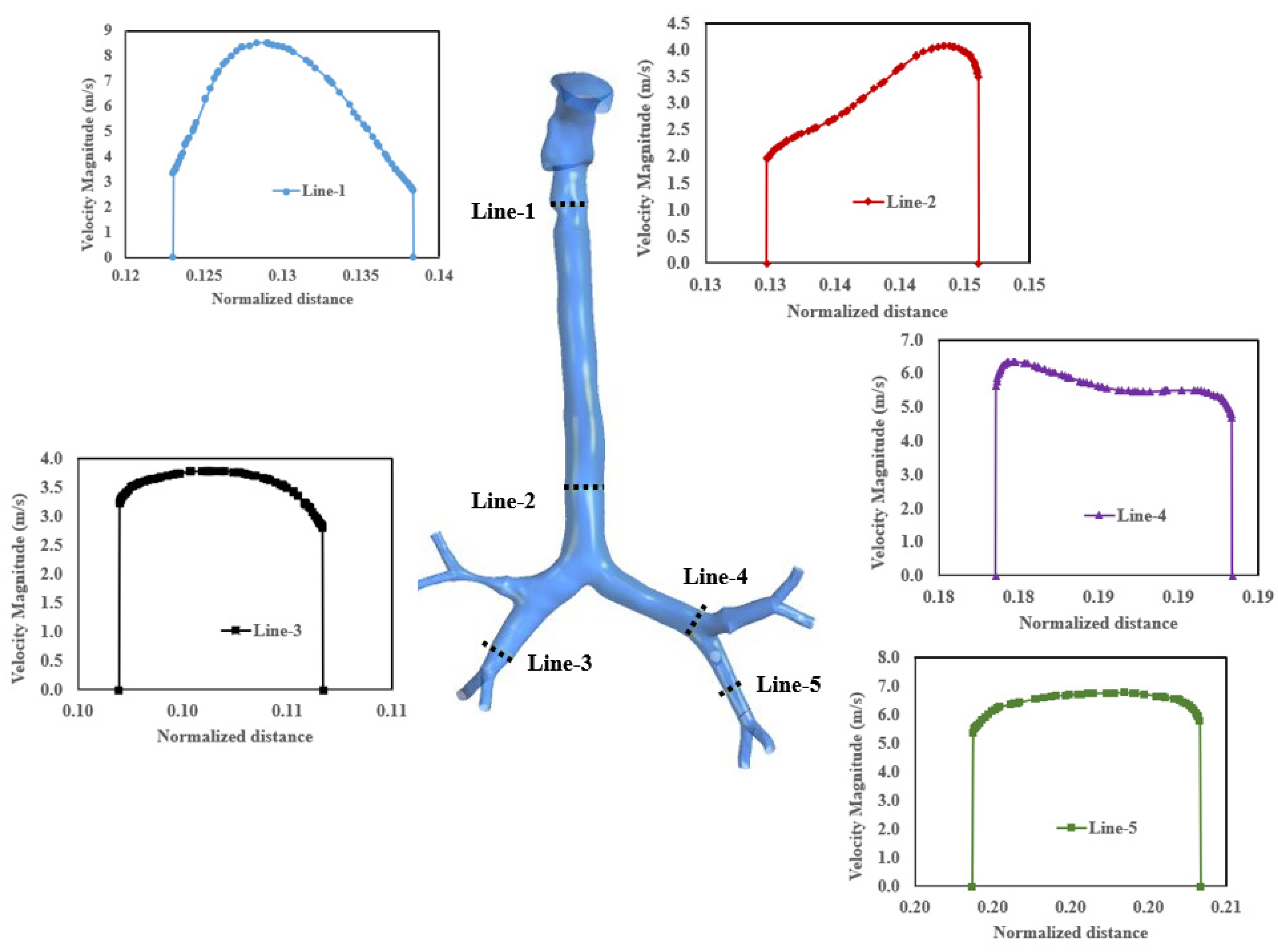
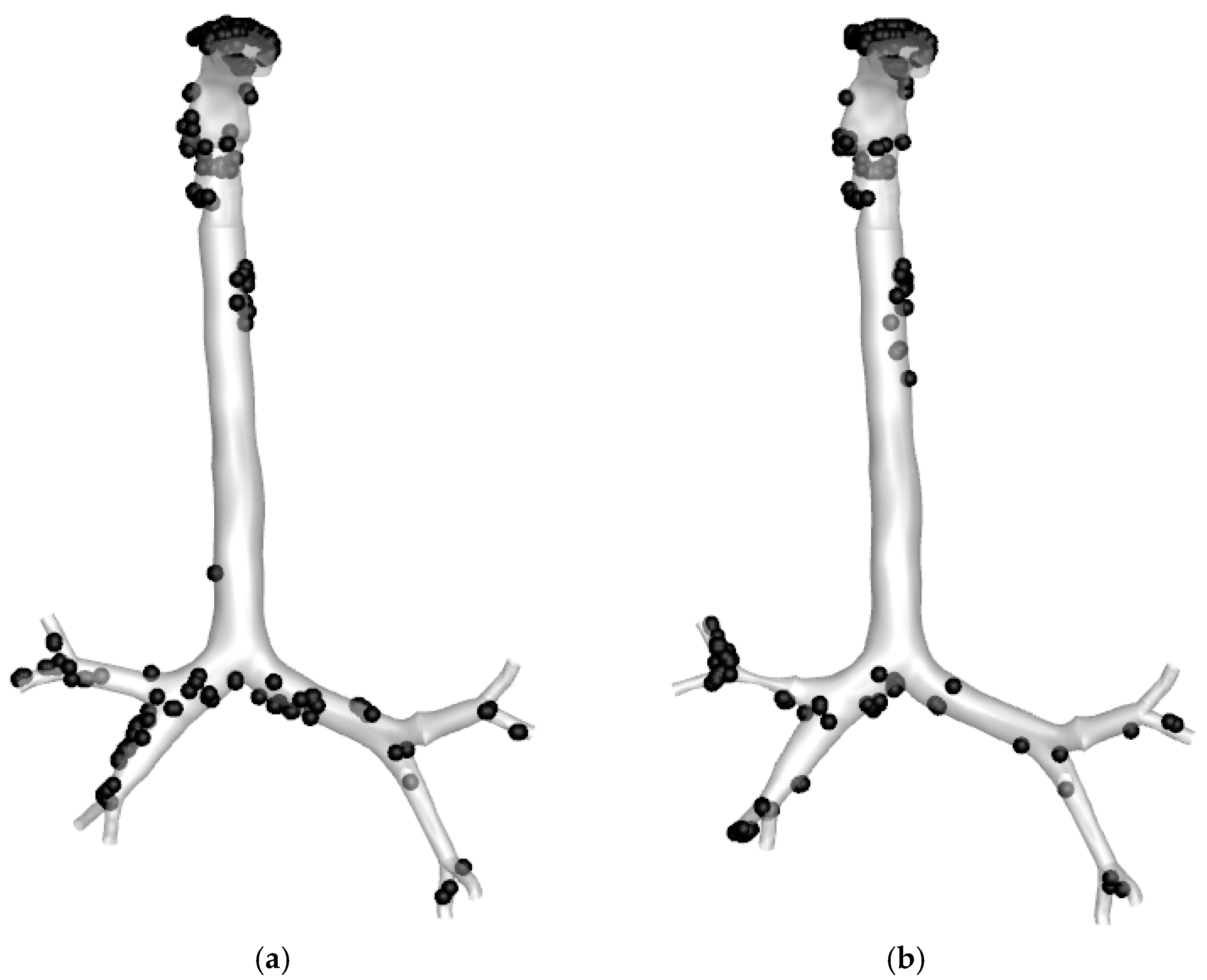
| Sydney Central East | Sydney North West | Sydney South West | Upper Hunter |
|---|---|---|---|
| 1. Cook and Phillip | 1. Paramatta North | 1. Bargo | 1. Singleton |
| 2. Randwick | 2. Richmond | 2. Bringelly | 2. Camberwell |
| 3. Rozelle | 3. St Marys | 3. Cambden | 3. MuswellBrook |
| 4. Chullora | 4. Vineyard | 4. Campbelltown | 4. Maison Dieu |
| 5. Earlwood | 5. Prospect | 5. Liverpool | 5. Mount Thorley |
| 6. Macquarie Park | 6. Rouse Hill | 6. Macarthur | 6. Wybong |
| 7. Lindfield | - | 7. Oakdale | 7. Bulga |
| - | - | - | 8. Aberdeen |
| - | - | - | 9. Merriwa |
| - | - | - | 10. Warkworth |
| Month | Sydney Central East 2018–2019 | Sydney Central East 2019–2020 | Sydney North West 18–19 | Sydney North West 2019–2020 | Sydney South West 2018–2019 | Sydney South West 2019–2020 |
|---|---|---|---|---|---|---|
| November | 0.199 | 0.201 | 0.092 | 0.227 | 0.189 | 0.245 |
| December | 0.144 | 0.260 | 0.084 | 0.276 | 0.206 | 0.416 |
| January | 0.186 | 0.324 | 0.100 | 0.299 | 0.237 | 0.431 |
| February | 0.144 | 0.149 | 0.066 | 0.133 | 0.184 | 0.201 |
| March | 0.165 | 0.138 | 0.101 | 0.118 | 0.165 | 0.154 |
| April | 0.190 | 0.146 | 0.147 | 0.145 | 0.194 | 0.188 |
| May | 0.220 | 0.167 | 0.190 | 0.197 | 0.258 | 0.190 |
| June | 0.254 | 0.200 | 0.224 | 0.253 | 0.237 | 0.209 |
| Respiratory Conditions | Asthma | COPD (Acute Exacerbation) | Breathing Abnormalities | |||||||||||||
|---|---|---|---|---|---|---|---|---|---|---|---|---|---|---|---|---|
| 2019–20 | 5-Years (Avg) | 2019–20 | 5-Years (Avg) | 2019–20 | 5-Years (Avg) | 2019–20 | 5-Years (Avg) | |||||||||
| Week | n | Crude Rate | n | Crude Rate | n | Crude Rate | n | Crude Rate | n | Crude Rate | n | Crude Rate | n | Crude Rate | n | Crude Rate |
| 1–7 September | 3559 | 44.0 | 3676.6 | 47.5 | 224 | 2.8 | 235.8 | 3.1 | 124 | 1.5 | 140.2 | 1.8 | 265 | 3.3 | 194.2 | 2.5 |
| 8–14 September | 3323 | 41.1 | 3608.0 | 46.6 | 178 | 2.2 | 229.2 | 3.0 | 151 | 1.9 | 141.6 | 1.8 | 282 | 3.5 | 191.8 | 2.5 |
| 15–21 September | 3320 | 41.1 | 3410.0 | 44.0 | 199 | 2.5 | 219.8 | 2.8 | 154 | 1.9 | 143.0 | 1.8 | 247 | 3.1 | 190.2 | 2.5 |
| 22–28 September | 3261 | 40.3 | 3276.6 | 42.3 | 200 | 2.5 | 220.8 | 2.9 | 132 | 1.6 | 128.2 | 1.7 | 258 | 3.2 | 198.6 | 2.6 |
| 29 September–5 October | 3198 | 39.5 | 2935.4 | 37.9 | 184 | 2.3 | 189.4 | 2.4 | 122 | 1.5 | 134.4 | 1.7 | 267 | 3.3 | 187.2 | 2.4 |
| 6–12 October | 2909 | 36.0 | 2963.6 | 38.3 | 175 | 2.2 | 182.4 | 2.4 | 127 | 1.6 | 146.8 | 1.9 | 207 | 2.6 | 197.0 | 2.5 |
| 13–19 October | 2887 | 35.7 | 2814.4 | 36.4 | 166 | 2.1 | 200.2 | 2.6 | 137 | 1.7 | 131.6 | 1.7 | 271 | 3.4 | 200.0 | 2.6 |
| 20–26 October | 2956 | 36.6 | 2778.8 | 35.9 | 193 | 2.4 | 239.0 | 3.1 | 154 | 1.9 | 127.8 | 1.6 | 255 | 3.2 | 203.8 | 2.6 |
| 27 October–2 November | 2863 | 35.4 | 2813.0 | 36.3 | 215 | 2.7 | 250.4 | 3.2 | 164 | 2.0 | 126.2 | 1.6 | 244 | 3.0 | 218.4 | 2.8 |
| 3–9 November | 2856 | 35.3 | 2817.4 | 36.4 | 217 | 2.7 | 236.2 | 3.1 | 163 | 2.0 | 129.0 | 1.7 | 206 | 2.5 | 199.8 | 2.6 |
| 10–16 November | 2829 | 35.0 | 2734.8 | 35.3 | 233 | 2.9 | 209.0 | 2.7 | 173 | 2.1 | 127.0 | 1.6 | 236 | 2.9 | 191.0 | 2.5 |
| 17–23 November | 2942 | 36.4 | 2708.4 | 35.0 | 263 | 3.3 | 208.8 | 2.7 | 183 | 2.3 | 139.4 | 1.8 | 251 | 3.1 | 201.0 | 2.6 |
| 24–30 November | 2871 | 35.5 | 2633.0 | 34.0 | 208 | 2.6 | 203.6 | 2.6 | 167 | 2.1 | 130.4 | 1.7 | 247 | 3.1 | 191.6 | 2.5 |
| 1–7 December | 2943 | 36.4 | 2692.4 | 34.8 | 240 | 3.0 | 196.6 | 2.5 | 196 | 2.4 | 125.6 | 1.6 | 269 | 3.3 | 216.2 | 2.8 |
| 8–14 December | 2867 | 35.5 | 2607.2 | 33.7 | 253 | 3.1 | 193.4 | 2.5 | 179 | 2.2 | 116.0 | 1.5 | 263 | 3.3 | 204.2 | 2.6 |
| 15–21 December | 2630 | 32.5 | 2378.0 | 30.7 | 229 | 2.8 | 198.2 | 2.6 | 177 | 2.2 | 116.8 | 1.5 | 214 | 2.6 | 201.6 | 2.6 |
| 22–28 December | 2021 | 25.0 | 1835.4 | 23.7 | 168 | 2.1 | 176.4 | 2.3 | 143 | 1.8 | 113.4 | 1.5 | 146 | 1.8 | 135.4 | 1.7 |
| 29 December–4 January | 2127 | 26.3 | 1858.8 | 24.0 | 166 | 2.1 | 133.4 | 1.7 | 182 | 2.3 | 117.8 | 1.5 | 135 | 1.7 | 113.2 | 1.5 |
| 5–11 January | 2333 | 28.8 | 2066.6 | 26.7 | 176 | 2.2 | 134.6 | 1.7 | 183 | 2.3 | 111.2 | 1.4 | 164 | 2.0 | 146.4 | 1.9 |
| 12–18 January | 2306 | 28.5 | 2239.8 | 28.9 | 158 | 2.0 | 136.2 | 1.8 | 151 | 1.9 | 119.6 | 1.5 | 188 | 2.3 | 171.6 | 2.2 |
| 19–25 January | 2479 | 30.7 | 2276.2 | 29.4 | 146 | 1.8 | 148.6 | 1.9 | 159 | 2.0 | 121.8 | 1.6 | 252 | 3.1 | 192.0 | 2.5 |
| 26 January–1 February | 2312 | 28.6 | 2151.4 | 27.8 | 140 | 1.7 | 171.6 | 2.2 | 125 | 1.5 | 107.8 | 1.4 | 254 | 3.1 | 203.2 | 2.6 |
| 2–8 February | 2409 | 29.8 | 2412.2 | 31.2 | 168 | 2.1 | 247.2 | 3.2 | 147 | 1.8 | 109.0 | 1.4 | 259 | 3.2 | 244.4 | 3.1 |
| 9–15 February | 2580 | 31.9 | 2593.6 | 33.5 | 220 | 2.7 | 351.0 | 4.5 | 149 | 1.8 | 115.2 | 1.5 | 323 | 4.0 | 276.4 | 3.6 |
| 16–22 February | 2582 | 31.9 | 2599.4 | 33.6 | 253 | 3.1 | 313.6 | 4.1 | 120 | 1.5 | 117.4 | 1.5 | 317 | 3.9 | 269.6 | 3.5 |
| 23 February–1 March | 2701 | 33.4 | 2603.4 | 33.6 | 239 | 3.0 | 272.0 | 3.5 | 132 | 1.6 | 107.0 | 1.4 | 306 | 3.8 | 272.8 | 3.5 |
| Selected Heart Conditions | Cerebrovascular Conditions | Chest Pain | Mental Health | Burns | Dehydration | |||||||||||||||||||
|---|---|---|---|---|---|---|---|---|---|---|---|---|---|---|---|---|---|---|---|---|---|---|---|---|
| 2019–20 | 5-Years (Avg) | 2019–20 | 5-Years (Avg) | 2019–20 | 5-Years (Avg) | 2019–20 | 5-Years (Avg) | 2019–20 | 5-Years (Avg) | 2019–20 | 5-Years (Avg) | |||||||||||||
| Week | n | Crude Rate | n | Crude Rate | n | Crude Rate | n | Crude Rate | n | Crude Rate | n | Crude Rate | n | Crude Rate | n | Crude Rate | n | Crude Rate | n | Crude Rate | n | Crude Rate | n | Crude Rate |
| 1–7 September | 2610 | 32.3 | 2523.8 | 32.6 | 513 | 6.3 | 495.6 | 6.4 | 675 | 8.3 | 711.4 | 9.2 | 3124 | 38.6 | 2988.2 | 38.6 | 49 | 0.6 | 52.0 | 0.7 | 47 | 0.6 | 50.8 | 0.7 |
| 8–14 September | 2645 | 32.7 | 2578.6 | 33.3 | 500 | 6.2 | 494.8 | 6.4 | 703 | 8.7 | 742.6 | 9.6 | 3185 | 39.4 | 3058.2 | 39.5 | 32 | 0.4 | 51.8 | 0.7 | 46 | 0.6 | 47.8 | 0.6 |
| 15–21 September | 2755 | 34.1 | 2510.8 | 32.4 | 510 | 6.3 | 495.2 | 6.4 | 747 | 9.2 | 727.8 | 9.4 | 3122 | 38.6 | 3016.6 | 38.9 | 36 | 0.4 | 51.0 | 0.7 | 46 | 0.6 | 48.4 | 0.6 |
| 22–28 September | 2733 | 33.8 | 2388.6 | 30.8 | 494 | 6.1 | 489.8 | 6.3 | 745 | 9.2 | 701.0 | 9.1 | 3222 | 39.8 | 2962.8 | 38.2 | 44 | 0.5 | 41.4 | 0.5 | 40 | 0.5 | 47.4 | 0.6 |
| 29 September–5 October | 2652 | 32.8 | 2195.8 | 28.4 | 490 | 6.1 | 431.2 | 5.6 | 683 | 8.4 | 692.6 | 9.0 | 3122 | 38.6 | 2612.0 | 33.8 | 39 | 0.5 | 52.8 | 0.7 | 37 | 0.5 | 47.4 | 0.6 |
| 6–12 October | 2347 | 29.0 | 2441.2 | 31.5 | 440 | 5.4 | 495.4 | 6.4 | 711 | 8.8 | 736.2 | 9.5 | 2810 | 34.7 | 3003.8 | 38.8 | 35 | 0.4 | 44.8 | 0.6 | 42 | 0.5 | 45.6 | 0.6 |
| 13–19 October | 2755 | 34.1 | 2454.0 | 31.7 | 581 | 7.2 | 493.2 | 6.4 | 734 | 9.1 | 739.2 | 9.6 | 3412 | 42.2 | 3113.4 | 40.2 | 33 | 0.4 | 44.0 | 0.6 | 39 | 0.5 | 46.4 | 0.6 |
| 20–26 October | 2618 | 32.4 | 2495.6 | 32.2 | 508 | 6.3 | 511.0 | 6.6 | 692 | 8.6 | 732.8 | 9.5 | 3410 | 42.2 | 3121.6 | 40.3 | 38 | 0.5 | 45.6 | 0.6 | 53 | 0.7 | 49.4 | 0.6 |
| 27 October–2 November | 2694 | 33.3 | 2476.2 | 32.0 | 552 | 6.8 | 483.4 | 6.2 | 714 | 8.8 | 747.6 | 9.7 | 3552 | 43.9 | 3114.4 | 40.2 | 29 | 0.4 | 48.6 | 0.6 | 42 | 0.5 | 56.2 | 0.7 |
| 3–9 November | 2522 | 31.2 | 2452.4 | 31.7 | 557 | 6.9 | 481.2 | 6.2 | 650 | 8.0 | 795.8 | 10.3 | 3511 | 43.4 | 3130.0 | 40.4 | 42 | 0.5 | 47.2 | 0.6 | 51 | 0.6 | 47.6 | 0.6 |
| 10–16 November | 2539 | 31.4 | 2486.8 | 32.1 | 552 | 6.8 | 482.8 | 6.2 | 636 | 7.9 | 778.8 | 10.1 | 3356 | 41.5 | 3127.2 | 40.4 | 40 | 0.5 | 43.2 | 0.6 | 49 | 0.6 | 51.4 | 0.7 |
| 17–23 November | 2576 | 31.9 | 2450.0 | 31.6 | 558 | 6.9 | 477.2 | 6.1 | 679 | 8.4 | 778.0 | 10.1 | 3433 | 42.4 | 3106.0 | 40.1 | 37 | 0.5 | 48.4 | 0.6 | 56 | 0.7 | 49.8 | 0.6 |
| 24–30 November | 2667 | 33.0 | 2516.2 | 32.5 | 508 | 6.3 | 476.0 | 6.1 | 672 | 8.3 | 784.8 | 10.2 | 3454 | 42.7 | 3064.0 | 39.6 | 27 | 0.3 | 46.8 | 0.6 | 49 | 0.6 | 55.8 | 0.7 |
| 1–7 December | 2577 | 31.9 | 2508.4 | 32.4 | 532 | 6.6 | 472.6 | 6.1 | 721 | 8.9 | 761.6 | 9.8 | 3419 | 42.3 | 3103.4 | 40.1 | 30 | 0.4 | 42.6 | 0.6 | 47 | 0.6 | 62.4 | 0.8 |
| 8–14 December | 2655 | 32.8 | 2543.6 | 32.8 | 506 | 6.3 | 493.4 | 6.4 | 728 | 9.0 | 728.2 | 9.4 | 3311 | 40.9 | 3057.8 | 39.5 | 35 | 0.4 | 46.6 | 0.6 | 43 | 0.5 | 52.6 | 0.7 |
| 15–21 December | 2574 | 31.8 | 2454.0 | 31.7 | 500 | 6.2 | 459.2 | 5.9 | 677 | 8.4 | 763.4 | 9.9 | 3020 | 37.3 | 2657.4 | 34.3 | 49 | 0.6 | 48.0 | 0.6 | 68 | 0.8 | 58.2 | 0.8 |
| 22–28 December | 1353 | 16.7 | 1468.8 | 19.0 | 326 | 4.0 | 308.6 | 4.0 | 558 | 6.9 | 624.6 | 8.1 | 1302 | 16.1 | 1356.8 | 17.5 | 36 | 0.4 | 40.6 | 0.5 | 47 | 0.6 | 45.4 | 0.6 |
| 29 December–4 January | 1524 | 18.8 | 1536.0 | 19.8 | 337 | 4.2 | 321.4 | 4.1 | 600 | 7.4 | 702.2 | 9.1 | 1390 | 17.2 | 1508.4 | 19.5 | 65 | 0.8 | 48.0 | 0.6 | 62 | 0.8 | 50.0 | 0.6 |
| 5–11 January | 1928 | 23.8 | 1861.4 | 24.0 | 515 | 6.4 | 436.6 | 5.6 | 700 | 8.7 | 725.0 | 9.4 | 2772 | 34.3 | 2368.6 | 30.6 | 42 | 0.5 | 41.6 | 0.5 | 64 | 0.8 | 64.6 | 0.8 |
| 12–18 January | 2254 | 27.9 | 2057.8 | 26.6 | 500 | 6.2 | 460.0 | 5.9 | 687 | 8.5 | 738.0 | 9.5 | 3009 | 37.2 | 2711.4 | 35.0 | 37 | 0.5 | 40.2 | 0.5 | 41 | 0.5 | 73.6 | 0.9 |
| 19–25 January | 2425 | 30.0 | 2157.8 | 27.9 | 539 | 6.7 | 478.6 | 6.2 | 705 | 8.7 | 751.8 | 9.7 | 3112 | 38.5 | 2770.8 | 35.8 | 30 | 0.4 | 41.2 | 0.5 | 48 | 0.6 | 65.2 | 0.8 |
| 26 January–1 February | 2175 | 26.9 | 2070.2 | 26.7 | 486 | 6.0 | 436.0 | 5.6 | 633 | 7.8 | 740.4 | 9.6 | 2938 | 36.3 | 2585.8 | 33.4 | 30 | 0.4 | 45.0 | 0.6 | 64 | 0.8 | 58.4 | 0.8 |
| 2–8 February | 2362 | 29.2 | 2369.6 | 30.6 | 568 | 7.0 | 490.4 | 6.3 | 645 | 8.0 | 764.0 | 9.9 | 3290 | 40.7 | 3080.6 | 39.8 | 49 | 0.6 | 46.0 | 0.6 | 56 | 0.7 | 53.4 | 0.7 |
| 9–15 February | 2591 | 32.0 | 2378.6 | 30.7 | 583 | 7.2 | 491.8 | 6.3 | 666 | 8.2 | 766.8 | 9.9 | 3385 | 41.9 | 3113.0 | 40.2 | 36 | 0.4 | 49.4 | 0.6 | 32 | 0.4 | 57.8 | 0.7 |
| 16–22 February | 2585 | 32.0 | 2431.6 | 31.4 | 582 | 7.2 | 497.6 | 6.4 | 688 | 8.5 | 768.8 | 9.9 | 3385 | 41.9 | 3113.8 | 40.2 | 29 | 0.4 | 48.8 | 0.6 | 43 | 0.5 | 47.2 | 0.6 |
| 23 February–1 March | 2531 | 31.3 | 2412.4 | 31.2 | 575 | 7.1 | 511.8 | 6.6 | 670 | 8.3 | 779.4 | 10.1 | 3382 | 41.8 | 3274.0 | 42.3 | 34 | 0.4 | 46.2 | 0.6 | 39 | 0.5 | 50.2 | 0.6 |
Publisher’s Note: MDPI stays neutral with regard to jurisdictional claims in published maps and institutional affiliations. |
© 2022 by the authors. Licensee MDPI, Basel, Switzerland. This article is an open access article distributed under the terms and conditions of the Creative Commons Attribution (CC BY) license (https://creativecommons.org/licenses/by/4.0/).
Share and Cite
Islam, M.S.; Fang, T.; Oldfield, C.; Larpruenrudee, P.; Beni, H.M.; Rahman, M.M.; Husain, S.; Gu, Y. Heat Wave and Bushfire Meteorology in New South Wales, Australia: Air Quality and Health Impacts. Int. J. Environ. Res. Public Health 2022, 19, 10388. https://doi.org/10.3390/ijerph191610388
Islam MS, Fang T, Oldfield C, Larpruenrudee P, Beni HM, Rahman MM, Husain S, Gu Y. Heat Wave and Bushfire Meteorology in New South Wales, Australia: Air Quality and Health Impacts. International Journal of Environmental Research and Public Health. 2022; 19(16):10388. https://doi.org/10.3390/ijerph191610388
Chicago/Turabian StyleIslam, Mohammad S., Tianxin Fang, Callum Oldfield, Puchanee Larpruenrudee, Hamidreza Mortazavy Beni, Md. M. Rahman, Shahid Husain, and Yuantong Gu. 2022. "Heat Wave and Bushfire Meteorology in New South Wales, Australia: Air Quality and Health Impacts" International Journal of Environmental Research and Public Health 19, no. 16: 10388. https://doi.org/10.3390/ijerph191610388
APA StyleIslam, M. S., Fang, T., Oldfield, C., Larpruenrudee, P., Beni, H. M., Rahman, M. M., Husain, S., & Gu, Y. (2022). Heat Wave and Bushfire Meteorology in New South Wales, Australia: Air Quality and Health Impacts. International Journal of Environmental Research and Public Health, 19(16), 10388. https://doi.org/10.3390/ijerph191610388









